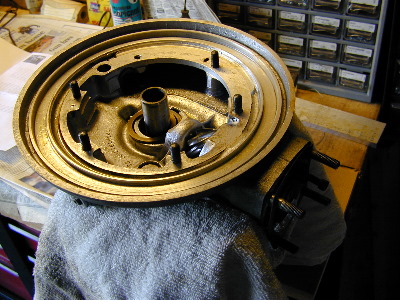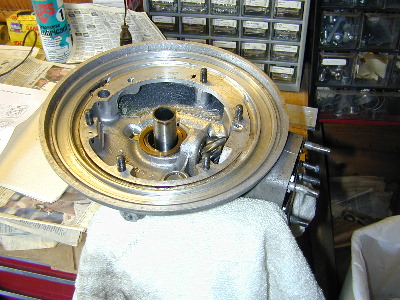

I've been having problems with oil leaking from the final drive and getting on the rear brakes. This has been a problem for some time, but as I don't usually go on long trips I've been living with it. As lond as I keep the drain hole clear, it doesn't get on thr brakes. Usually, after a typical 30 or 40 mile ride, I'll get a small puddle on the floor after the ride, and no harm done.
On the Alaska trips, however, it has become a pain. The rides each day are long enough that the oil gets on the side of the rear wheel, and makes me nervous. On Alaska 3 in California last year (2008), I used half a Q-tip suffed into the drain hole, and replaced it at every stop. Reasonably effective, but certainly not very cool!
When we (Dick and I) got together in Chelmsford last Fall, we decided to replace the oil seal which I thought was the problem. We were able to get the final drive off the bike, and the crown wheel cover removed. Click on any picture for full size.
This is the main housing. The driveshaft connects on the right, and drives the pinion gear which is just visable. The crown wheel assembly sits over the axle tube, and is supported by a roller bearing.
This is the crown wheel assembly, with the shims or spacers used to set the tooth engagement sitting loose.
This is the cover which holds the crown wheel in place. The seal that we are replacing goes into this cover.
Once we had disassembled the final drive this far, we found that the bearing that supported the pinion shaft did not feel too good. So, after consultation with a vintage BMW mechanic and lots of soul searching, it was decided to disassemble the final drive the rest of the way, and replace any bearing required. Here the main housing is mounted in my vise, ready to start removing the shaft. To remove the pinion shaft requires a couple of special tools, which I bought.
First step is to bend flat the washer which is holding the pinion nut. I used a cold chisel to flatten it. The first special tool is already installed, it is a ring which engages two slots in the housing, and 5 teeth in the splined coupling. This keeps the shaft from turning while you loosen the nut. The nut is supposed to be 80-87 Ft-lbs, but on my bike was only about 50 Ft-lbs.
Here are the washer and nut. The washer has two tabs that extend into the grooves on the splined coupling, keeping it (the washer, and thus the nut) from rotating. I hope I can get a new washer.
This is a shot of the splined coupling, with the nut and washer removed. The tool which held the coupling from rotating has been partially removed, to show it better.
Here is the splined coupling. It just slides right off.
The slotted treaded ring which holds the double ball bearing in place is now exposed. The grease seal shown is actually mounted in the ring. The second special tool that I bought engages the four 6mm slots to unscrew the ring.
Here is the tool in place. It is a 41mm nut drilled for 4 screws with 6mm square heads, which act as pins to engage the slots. I ran into a small problem, as the pins were to large to engage the slots. I filed them down a few thousandths, and lightly tapped with a hammer to be sure they were all fully seated. The ring came loose without requiring heat.
Before turning the special tool with a 41mm socket, the nut is loosly replaced with a waswher. This keeps the tool from popping out of the slots.
Here is the ring removed, still mounted on the tool. This is the side that was facing the bearing.
Here is the other side. Again, the tool is still mounted to the ring.
Here is the threaded ring itself, with its oil seal stil in place.
Here is the pinion shaft, with the threaded ring removed. There is a spacer shown in front of the bearing.
This is the axle tube. It is pressed into the housing. In order to get the roller bearing and seal out of that cavity, I need to remove the axle tube. I heated the housing around the tube, and drove it out using the rear axle.
Here is the axle tube, after being driven out using the rear axle.
Heating the housing to remove the axle tube allowed the roller bearing to come out too. The spacer shown here came off the front of the double ball bearing on the pinion shaft.
Here is the housing with the axle tube and roller bearing removed. I still need to remove the oil seal shown here.
I heated the housing around the area of the double bearing, and when it got hot enough the shaft fell out. The spacer goes between the bearing and the housing.
Here is the housing with the pinion shaft removed. You can see the threads for the threaded ring.
This is looking down the housing along the line of the pinion shaft.